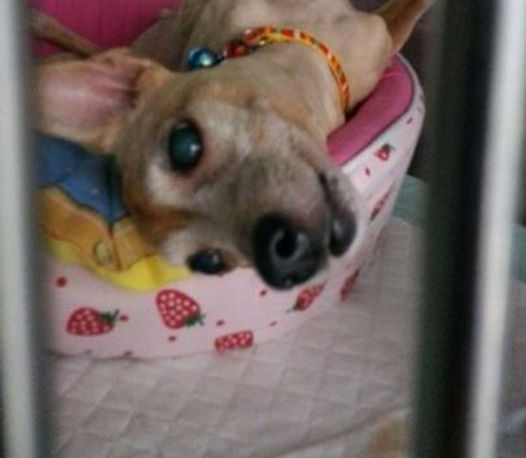
SERVICES
RESOURCES
LIGHT OF LIFE
VETERINARY CLINIC
GOLDEN YEARS

The care of older pets is directed at preventing premature aging, minimizing physical and emotional stresses, managing chronic medical conditions, and meeting the special needs of seniors [2,4,6].
Ensuring that the process of aging will not reduce their quality of life and they remain carefree and happy [1,2].
The art of caring and managing Senior Health should be carefully crafted and best achieved by working closely with an experienced medical team like us.
HOW OLD IS OLD?

Above: Age chart to help owners appreciate the life stages their pet is in, understand the physiological age and how to provide the needed care [3]. Table adapted from Treatment and Care of the Geriatric Veterinary Patient. (10lb = 4.54kg)
GERIACTRIC (SUPER SENIORS)
19 YEAR OLD
SUPER SENIOR
15 YEAR OLD
SUPER SENIOR
20 YEAR OLD
SUPER SENIOR
18 YEAR OLD
SUPER SENIOR
16 YEAR OLD
SUPER SENIOR
19 YEAR OLD
SUPER SENIOR
For further discussion about pet care for different species and life stages, please click below:
YOU DON'T
STOP HAVING FUN
WHEN YOU GET OLD.
YOU GET OLD
WHEN YOU
STOP HAVING FUN.
BESPOKE


Senior dog with arthritis hospitalized because of an open pressure sore, still enjoying a bit of a walk (bottom) and a good laugh (left) with assistance from the helium balloons.

Senior dog under the watchful eye of the vet (ICU) after surgery.

Senior dog hospitalized for observation, throwing a tantrum because she was bored and not impressed by the staff.

Senior guide dog admitted for observation.

Senior dog that only allows one specific person in the clinic to trim his nails and clean his ears.

Senior Chinchilla admitted for fur trimming.

Senior dog taking an afternoon nap at the reception lobby while being hospitalized.
RECOMMENDATIONS
While every pet should have an annual physical examination, a pet older than 7 years who is in relatively good health should have a complete veterinary examination at least once a year, preferably twice a year [2].
THE BODY SYSTEMS TO MONITOR FOR GERIATRICS [1,2,3,4,5,6,7]:
- 01
- 02
- 03
- 04
- 05
- 06
- 07
- 08
COGNITIVE HEALTH
We have witnessed Cognitive dysfunction syndrome (CDS) develop gradually in aged dogs, cats, and even rabbits in our clinical cases.
As our pets enjoy better medical health care and have longer lifespans, CDS becomes a growing concern for them.
This condition is considered the animal equivalent to human Alzheimer’s disease (AD) or dementia because of some level of similarities listed below.
Studies on aged dogs with CDS and humans with AD showed that beta-amyloid plaques accumulated in the brain parenchyma and cerebral blood vessels of both resulted in the development of cerebral amyloid angiopathy,
which may lead to reduced blood flow, infarctions, micro-hemorrhages, and hypoxia of the brain. cerebral atrophy and ventricular dilation associated with neuronal loss, which may be caused by decreased neurogenesis, oxidative stress, and chronic inflammation.
There is currently a lack of effective medication to treat CDS, which means there is no tangible management means for such patients.
Research has, instead, shown that dietary adjustments, antioxidant and circulatory supplementation and support, given at an early stage, may improve clinical signs, prevent rapid degeneration, and ensure a better quality of life. [8]
The DISHA guideline is for the clients to determine if cognitive dysfunction is present.
DISHA stands for disorientation, interactions, sleep‐wake cycle disturbances, house‐soiling, and activity level alterations [3].

Table adapted from Treatment and Care of the Geriatric Veterinary Patient.
NUTRITIONAL OPTIMISATION
a) Antioxidants-fortified diet to remove toxic free radicals
- For example, diets with added Vitamin E, Vitamin C, Vitamin Bs, L-Lysine, L-tryptophan, L-carnitine, Beta-carotene, omega-3 fatty acids, and arginine.
a) Easily digested food
- increase animal-based protein is easier to digest for the carnivorous pet cats.
- reduced-calorie diet by restricting carbohydrate.
PHARMACEUTICAL INTERVENTION [9]
a) Selegiline (monoamine oxidase B inhibitor L-deprenyl )
- to increase levels of catecholamines in the cortex and hippocampus and may provide neuroprotection against free radicals, improving the clinical signs of CDS.
b) Propentofylline (xanthine derivative)
- to stimulate blood flow to the brain and other organs, such as the heart and skeletal muscles, and may therefore improve dullness, depression, and lethargy of elderly human patients.
c) Memantine
- inhibits beta-amyloid accumulation and prevents neuronal death.
DIETARY SUPPLEMENTS [9]
a) Medium-chain triglycerides ^
- Caprylic acid (C8) aka octanoic acid
- Capric acid (C10) aka decanoic acid or decylic acid
-they convert readily into ketone bodies, like beta-hydroxybutyrate, acetone, and acetoacetate by the liver and the astrocytes in the brain, which acts as an alternative energy source for the brain when glucose metabolism reduces with aging.
^MCT is not coconut oil but can be extracted from coconut oil.
Do not feed MCT if your pet may have suspected, undiagnosed liver issues and /or diabetes.
b) Apoaequorin
- a calcium-buffering protein (Jellyfish protein) that may have some level of neuroprotective properties.
c) S-adenosylmethionine (SAMe)
-an endogenous methyl donor that was shown to reduce oxidative stress on the brain by increasing glutathione levels and decreasing lipid peroxidation.
**Please consult your attending veterinarian before starting any dietary and supplement therapy because most patients with suspected CDS are typically over eight years old, and many of them can have pre-existing diseases, such as chronic kidney issues and/ or liver diseases, cancer, heart disease, periodontal disease, diabetes, or polyarthritis that may not be suitable for certain medication or supplements.
ANNUAL GERIATRIC MEDICAL PROTOCOL [2]
This should include:
-
Complete blood count
-
Blood chemistries
-
Blood pressure reading
-
Tear production measurement
-
Corneal surface assessment
-
Intraocular pressure (IOP) measurement
-
Retina scan
-
Ear drum scope
-
Oral cavity examination
-
Mobility and weight bearing analysis
-
Skin and fur coat examination
-
Parasite examination
-
Urinalysis
-
Chest x-ray and electrocardiogram as needed
-
Routine dental care and maintenance
RELATED ARTICLES
Attribution:
1. Coffey, L.T. (2015). My Old Dog. Rescued Pets with Remarkable Second Acts. California: New World Library
2. Davies, M. (1996). Canine and Feline Geriatrics. UK: Wiley-Blackwell
3. Gardner, M., McVety, D. (2017). Treatment and Care of the Geriatric Veterinary Patient. UK: Wiley-Blackwell
4. Gram, W.D.; Milner, R.J.; Lobetti, R. (2018). Chronic Disease Management for Small Animals. USA: Wiley-Blackwell
5. Landsberg, G.; Madari, A.; Zilka, N. (2017). Canine and Feline Dementia. Molecular Basis, Diagnostics and Therapy. Switzerland: Springer
6. Shanan, A.; Pierce, J.; Shearer, T. (2017). Hospice and Palliative Care for Companion Animals. Principles and Practice. UK: Wiley-Blackwell
7. Shojai, A.D. (2010). Complete Care for Your Aging Cat, 2nd Ed. US: Wiley
8. Haake J, Meyerhoff N, Meller S, et al. Investigating Owner Use of Dietary Supplements in Dogs with Canine Cognitive Dysfunction. Animals (Basel). 2023;13(19):3056. Published 2023 Sep 29. doi:10.3390/ani13193056. Accessed 9 Dec 2023
9. Sibert, Lynne (Sept/Oct 2017). Today's Veterinary Practice. Management of Dogs and Cats with Cognitive Dysfunction. https://todaysveterinarypractice.com/neurology/management-of-dogs-and-cats-with-cognitive-dysfunction/. Accessed 10 Dec 2023
LOCATION
Blk 703 Bedok Reservoir Road
#01-3508 Singapore 470703
CONTACT
Tel: 6243 3282
(By Appointment Only)
Email: AskLightofLifeVet@outlook.com
OPERATING HOURS
WED & SUN
5 pm to 10 pm
THURS TO SAT
2 pm to 4 pm, 5 pm to 10 pm
CLOSED MON, TUES
& ALL PUBLIC HOLIDAYS







